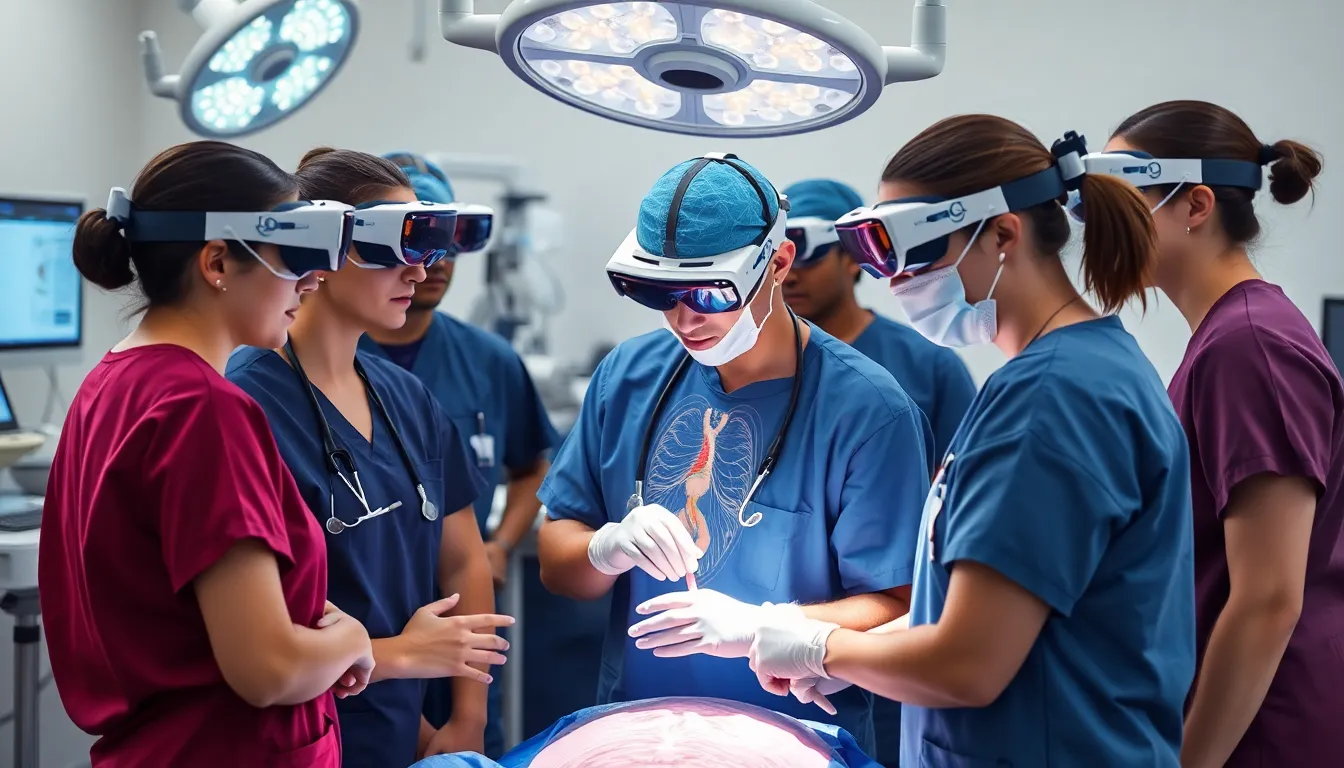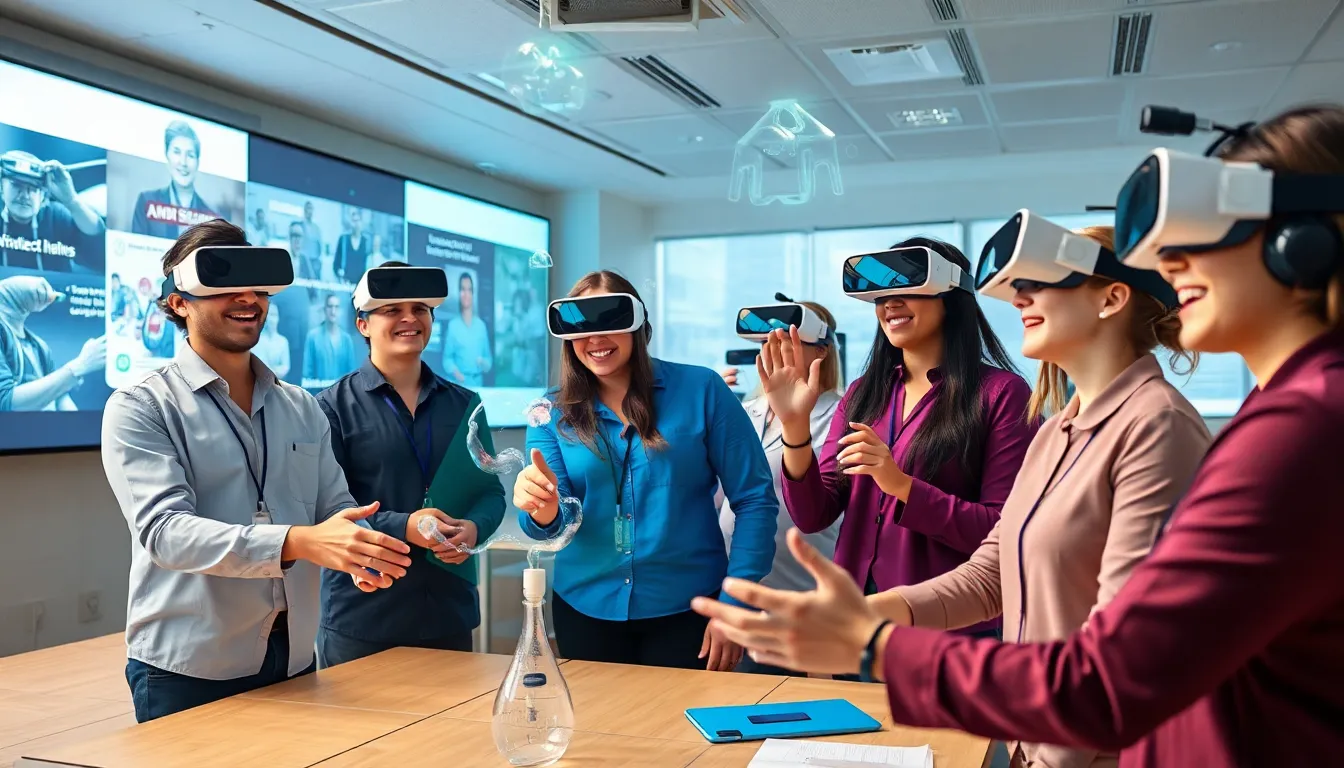Imagine a world where training isn’t just a dull lecture or a monotonous manual. Instead, it’s an exhilarating journey through a virtual landscape where learners can interact with lifelike simulations. Augmented reality (AR) is transforming the way we train, making it not only effective but also downright fun. Who wouldn’t want to practice complex procedures while battling virtual dragons or navigating a spaceship?
Table of Contents
ToggleOverview of Augmented Reality for Training
Augmented reality transforms training by integrating virtual elements into the real world. This technology enhances learning through interactive simulations that cater to various sectors, including healthcare, manufacturing, and education. AR enables learners to practice skills in a safe environment, allowing for immediate feedback and assessment.
Learners engage with realistic scenarios, improving retention rates and knowledge application. For instance, medical professionals can perform virtual surgeries, gaining hands-on experience without risking patient safety. In manufacturing, AR guides workers through intricate assembly processes, minimizing errors and training time.
The integration of AR into training programs increases learner motivation. Interactive features, such as gamification, make lessons enjoyable and promote active participation. Organizations utilizing AR often experience reduced training costs and improved employee performance.
Data shows that AR enhances knowledge retention by up to 75% compared to traditional methods. This statistic underscores the effectiveness of AR in creating memorable learning experiences. Furthermore, AR training environments adapt to individual learner needs, providing customized paths for skill development.
Companies adopting AR for training can also collect valuable data on learner progress. This insight allows for targeted improvements in training materials and methods. As industries continue to evolve, augmented reality stands out as a crucial tool in shaping the future of training and education.
Benefits of Augmented Reality in Training

Augmented reality revolutionizes training, offering numerous benefits that enhance the learning process. From interactive experiences to better skill retention, its impact is significant.
Enhanced Learning Experiences
AR creates immersive environments, making training more engaging. Learners interact with virtual elements superimposed on the real world, allowing for hands-on practice without real-world consequences. In healthcare, for instance, medical trainees engage in simulated surgeries that mimic actual procedures. Such immersive experiences foster deeper understanding and application of concepts. By utilizing game-like scenarios, AR captures attention and motivates participants, encouraging exploration and experimentation. Each training session transforms into a dynamic adventure, ensuring that lessons resonate long after the experience ends.
Improved Retention Rates
Data signifies that AR boosts knowledge retention by up to 75%, surpassing traditional training methods. Engaging with material actively leads to better recall and understanding. Feedback during AR training sessions occurs instantaneously, reinforcing learning and facilitating immediate correction of mistakes. This approach solidifies concepts as learners apply skills in real-time scenarios. Users often report improved confidence and readiness for real-world applications after AR training. Customized learning paths further enhance retention, catering to each learner’s unique needs and progress. AR establishes connections between knowledge and practice, ensuring long-lasting outcomes.
Applications of Augmented Reality for Training
Augmented reality provides transformative applications across various sectors, enhancing training efficiency and engagement.
Healthcare Training
Healthcare professionals benefit significantly from AR, which allows them to practice complex procedures in a risk-free environment. During virtual surgeries, they receive immediate feedback, enabling skills refinement without endangering patients. Studies point to improved confidence levels among medical trainees, resulting in better preparation for real-life situations. AR simulations replicate actual scenarios, ensuring learners grasp critical concepts effectively. Incorporating AR into classrooms accelerates the learning process, with retention rates improving by up to 75% compared to traditional methods.
Industrial and Manufacturing Training
AR has revolutionized training in industrial and manufacturing contexts by guiding workers through intricate assembly processes. Users can see step-by-step instructions overlaid on real-world equipment, reducing errors and minimizing training time. Productivity increases as workers become familiar with complex machinery through practical experience. Data supports that AR-enhanced training cuts onboarding time significantly, enabling quicker adaptation to workplace demands. Real-time error detection further sharpens skills, ultimately leading to improved operational efficiency.
Education and Skill Development
In educational settings, AR creates immersive learning experiences that engage students at all levels. Interactive scenarios simulate real-world problems, fostering critical thinking and collaboration among peers. Research indicates that students involved in AR programs demonstrate higher engagement and better retention of information. Tailored learning experiences accommodate diverse learning styles, ensuring all students benefit from personalized training paths. By integrating AR into curricula, educators promote active learning and prepare students for future challenges effectively.
Challenges and Limitations
Augmented reality (AR) in training faces several challenges and limitations that hinder its widespread implementation across industries.
Technology Barriers
Technological constraints significantly affect AR’s effectiveness in training environments. Many organizations lack the infrastructure to support advanced AR solutions, such as high-speed internet and compatible devices. Software compatibility issues often arise, preventing seamless integration with existing training systems. Additionally, some users may experience discomfort when using AR headsets, limiting their willingness to engage in immersive experiences. Security concerns also present notable barriers, as sensitive data might be exposed during AR applications. Addressing these technology-related obstacles is essential for maximizing AR’s potential in training.
Cost Considerations
Cost plays a crucial role in the adoption of AR for training purposes. Developing high-quality AR content and acquiring the necessary hardware can require significant financial investment. Smaller organizations may struggle to allocate resources for creating and maintaining AR training programs. Continuous updates and improvements further add to long-term costs. These factors may lead some companies to prioritize more cost-effective training solutions, hindering the integration of AR technology. Balancing the initial investment against potential benefits remains a key consideration for decision-makers exploring AR training options.
Future Trends in Augmented Reality for Training
Advancements in augmented reality (AR) technology will shape the future of training across various sectors. Enhanced hardware, such as lightweight headsets with improved battery life, increases accessibility for learners. Integration of artificial intelligence alongside AR provides personalized learning experiences, adapting scenarios to individual performance levels.
Significant growth in mobile AR applications enables training on smartphones and tablets, eliminating the need for specialized equipment. Virtual collaboration tools are becoming integral, allowing remote participants to engage in real-time training sessions. Enhanced analytics capabilities will help organizations track learner progress and optimize training materials through data-driven insights.
Greater focus on gamification features in AR training can boost learner motivation. Research indicates up to 75% knowledge retention with engaging, game-like scenarios. Development of industry-specific AR simulations allows companies to tailor experiences to unique training needs. For instance, in healthcare, surgical simulations become increasingly sophisticated, offering realistic scenarios for skill development.
Emphasis on multi-user environments fosters teamwork and collaboration among participants. Tools for real-time feedback and assessment create a continuous improvement loop, refining skills instantaneously. As AR applications evolve, integration with existing training programs ensures seamless implementation and enhances the overall learning experience.
Emerging trends suggest a growing commitment to addressing challenges associated with AR. Companies are prioritizing investment in infrastructure, ensuring compatibility with existing technologies. Security measures will expand to protect sensitive data during training processes, encouraging widespread adoption across industries.
Augmented reality is reshaping the landscape of training across diverse sectors. By creating immersive and interactive learning experiences, it enhances engagement and retention while allowing learners to practice skills in safe environments. The integration of AR not only boosts motivation through gamification but also provides immediate feedback, fostering confidence and readiness for real-world applications.
As technology continues to advance, the potential for AR in training will only grow. Organizations that embrace this innovative approach can expect significant improvements in employee performance and overall training efficiency. The future of training is bright with augmented reality at the forefront, promising to make learning more effective and enjoyable.





